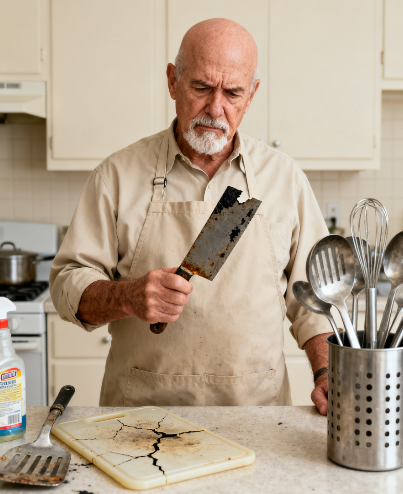
This Cheap Kitchen Tool Most People Have Is Secretly Full of…
You’ve had it for years. It might have been a wedding gift, a dollar-store find, or an impulse buy from a grocery store checkout line. It sits in your kitchen drawer, humble and unassuming, used for everything from scrambling eggs to mixing batter. It’s your trusty plastic spatula, and it’s harboring a secret that would make you think twice about your next batch of pancakes.
For those of us who’ve cooked family meals for decades, our kitchen tools are like old friends. We don’t think much about them until they break. But what if one of the most common tools in your kitchen is slowly breaking down, releasing a hidden payload into your food with every stir, scrape, and flip?
The secret isn’t about the spatula itself, but what happens to it over time. That inexpensive plastic utensil is secretly full of… microscopic damage.
The Hidden World of Scratches and Scars
Think about your plastic spatula. How many times has it scraped the rough surface of a non-stick pan? How many times has it been washed in the dishwasher, jostling against other utensils under a spray of hot water and harsh detergent? Each of these interactions leaves a mark.
To the naked eye, your spatula might just look a little worn. But under a microscope, its surface would tell a different story: a landscape of tiny scratches, gouges, and cracks. These microscopic imperfections are more than just cosmetic; they’re a perfect hiding place and a release valve for something you don’t want in your dinner.
The Unseen Ingredient: Microplastics
This is the unsettling truth. Every time you use a worn plastic spatula, especially with heat, you’re likely contributing to microplastic contamination in your food. Microplastics are tiny plastic particles, often invisible to the eye, that shed from larger plastic items as they degrade.
The process is simple:
- Heat and Stress: When you use a plastic spatula to stir a hot sauce or flip food in a sizzling pan, the heat and physical stress accelerate the breakdown of the plastic.
- Shedding: Tiny fragments break loose from the scratched and weakened surface of the utensil.
- Migration: These fragments mix directly into your food.
While the long-term health effects of microplastic ingestion are still being studied, the idea of voluntarily adding plastic particles to a home-cooked meal is unsettling enough for many. For a generation that has championed home cooking as a path to health, this is a silent betrayal by a trusted kitchen companion.
The Chemical Leaching Concern
Beyond the physical plastic particles, there’s another potential issue: chemical leaching. Many plastics are made with additives like phthalates or BPA (though many are now BPA-free) to make them flexible and durable. As the plastic breaks down from heat and wear, these chemicals can more easily migrate into food, particularly fatty or acidic foods like tomato sauce or oil-based dressings.
A Simple Solution for a Safer Kitchen
The good news is that this is one of the easiest kitchen problems to solve. You don’t need to spend a fortune.
- The Inspection: Take your plastic spatula out of the drawer right now. Hold it up to the light. Run your finger over the edge that scrapes the pan. Do you see any cloudiness, deep scratches, or feel any roughness? If the answer is yes, it’s time for a replacement.
- Choose Wisely: The safest alternatives are:
- Silicone Spatulas: High-quality, food-grade silicone is heat-resistant, flexible, and far less prone to scratching and degrading than plastic. It’s non-porous, meaning it won’t harbor bacteria or shed microplastics.
- Wooden Utensils: Wood is a classic, natural choice. While it can wear down over time, it doesn’t introduce synthetic particles into your food. Just be sure to avoid using it with raw meat to prevent bacterial contamination and to let it dry thoroughly.
- Retire the Old Faithful: Don’t feel bad about retiring your old spatula. It has served you well. But think of it like replacing a worn-out tire—it’s a necessary maintenance step for safety.
This isn’t about sparking fear, but about fostering awareness. The goal of cooking at home is to nourish our bodies and our families with wholesome, intentional ingredients. By making a simple switch from a worn plastic tool to a safer alternative, you’re taking one more step to ensure that the food you make is as pure and healthy as you intend it to be. That cheap kitchen tool has served its purpose. Now, it’s time to upgrade to something that protects your health as well as it flips your eggs.